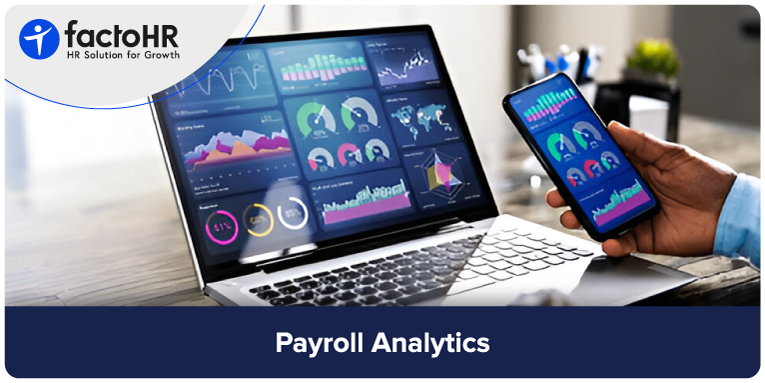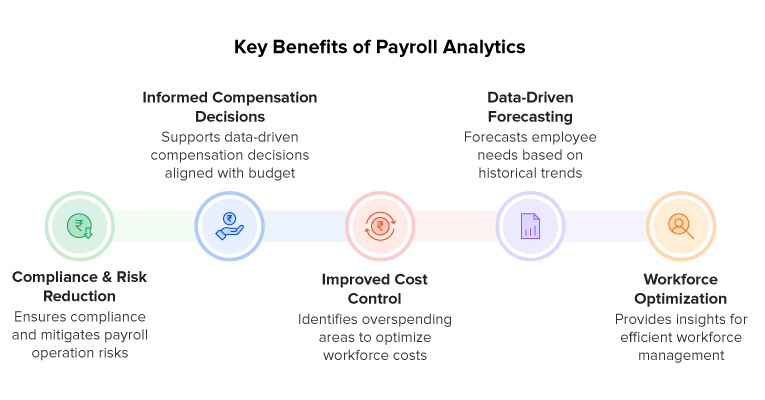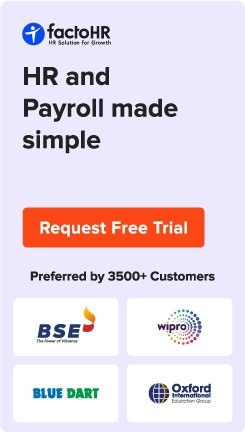Payroll Analytics 2025: Data-Driven HR & Strategic Decision-Making

Table of Contents
Organizations typically allocate approximately 70% of their operating expenses to their workforce. Payroll data includes working hours, deductions, benefits, taxes, and remuneration of employees in an organization. By analyzing payroll data, organizations gain a comprehensive understanding of their workforce, revealing salary trends, turnover rates, and other critical insights.
Modern payroll systems have evolved from simple wage calculators into powerful analytics tools that generate detailed reports, helping businesses make informed decisions. Effective payroll analytics ensures employees are paid accurately and on time while providing valuable operational and financial insights.
Payroll analytics enable organizations to optimize costs, workforce optimization, and refine financial strategies. Ultimately, payroll data is an untapped asset that drives better decision-making and strengthens overall organizational performance.

What is Data Analytics in Payroll?
Payroll analytics is the process of collecting, analyzing, and interpreting payroll data to gain insights and improve business payroll operations. With analytics, HR can make data-driven decisions to optimize workforce management strategies and improve the overall operational efficiency of an organization.
Why Payroll Analytics Matters in Strategic HR?
Payroll analytics plays a key role in determining the strategic priorities of tasks undertaken within the organization. By focusing on key aspects of payroll analytics, such as cost analysis, compliance tracking, and workforce planning, finance and HR departments can reduce payroll and compliance risks while improving operational efficiency. HR managers can leverage these insights to enhance employee retention, make data-driven decisions, optimize workforce allocation, manage expenses, and align HR objectives with broader organizational goals.
Data Collection and Analysis
Effective payroll analytics starts with collecting and integrating data from systems like payroll, time tracking, and HR platforms. Consolidating this data ensures accuracy and consistency. Using analytics techniques to analyze collected data, revealing trends, identifying anomalies, and exploring relationships between factors like performance, pay, and retention, enabling smarter, data-driven decisions.
Improved Employee Retention
Through payroll data analysis, organizations can gain valuable insights into the factors that affect employee satisfaction and retention. With these insights, HRs can develop strategies to reduce turnover and increase employee engagement.
Strategic Workforce Planning
HR teams can utilize analytics for workforce planning by forecasting future employee requirements based on historical data and organizational growth projections, thereby reducing the likelihood of understaffing and overstaffing.
Optimizing Payroll Processes
Payroll data analytics identify areas to streamline and optimize the payroll process. Analyzing payroll cycle duration, error rates, and discrepancies can help organizations identify bottlenecks and improve efficiency, leading to faster and more accurate payroll processing, saving time and resources.
Identifying Trends and Patterns
Payroll data provides valuable insights into your workforce, helps to identify trends, patterns, and anomalies that support better decision-making, cost control, and improved workforce management. By analyzing factors such as overtime, time-off trends, and salary distribution, organizations can pinpoint opportunities for operational improvements and strategic adjustments.
Alignment with Business Objectives
Payroll analytics offers insights into employee performance, workforce expenses, and an organization’s overall financial status. Analyzing payroll data allows HR teams to gain a deeper understanding of the workforce, identify opportunities for improvement, and make informed decisions that contribute to the organization’s strategic objectives.

What are the Key Benefits of Using Payroll Analytics
The key benefits of using payroll analytics include enhancing payroll accuracy, managing expenses effectively, making data-informed decisions, optimizing workforce management, ensuring compliance, increasing employee retention, improving overall operational efficiency, and enabling seamless integration with existing tools.

Cost Optimization
Payroll is often the most significant expense for an organization, and controlling these costs is very important for maintaining profitability. Analyzing payroll data to identify areas of overspending, such as overtime, idle time, workforce inefficiencies, and unnecessary expenses, provides a real-time view of expenses. This enables organizations to optimize their workforce, improve efficiency, accurately predict payroll expenses, and effectively manage finances.
Workforce Optimization
Payroll analytics can provide in-depth insights into workforce trends and patterns, enabling organizations to optimize their workforce management. By analyzing payroll data, organizations can identify skill gaps, anticipate employee requirements, and formulate plans for managing the workforce efficiently.
Informed Compensation Decisions
The analytics supports finance and HR teams to make informed compensation decisions, aligning with the organization’s budget, by providing data-driven insights. It enables the monitoring of employee expense patterns and financial trends, allowing for informed decisions about raises, bonuses, and hiring based on factual data.
Data-Driven Forecasting
HRs can use payroll data analytics to forecast employee requirements based on past trends. This helps forecast busy seasons, adjust staffing levels accordingly, and avoid the expense of overstaffing or understaffing. Using predictive analytics enables organizations to prepare for future workforce needs with improved efficiency.
Compliance & Risk Reduction
Payroll analytics and tracking data help ensure compliance with labor laws, tax regulations, and other statutory requirements, thereby maintaining compliance with legal standards. If discrepancies or compliance issues are detected, your system can alert you in real time to address the issue before it leads to penalties. Additionally, it can help identify and mitigate potential issues in payroll operations.
Payroll Analytics Tools & Technologies
Payroll analytics tools range from simple spreadsheet applications, such as Excel, to advanced HR analytics software. Tools and technologies used in payroll analytics include advanced software like HRMS, data analysis platforms like R and Sisense, and business intelligence (BI) tools like Power BI and Tableau. These tools help get insights from payroll data to understand workforce trends, expenses, and the impact of operational strategies.
On-premises solutions involve hosting applications and data on an organization’s servers and hardware. In contrast, cloud-based solutions are hosted on remote servers managed by the service provider and accessed via the internet.
Integrating payroll with HR, finance, and ERP systems, along with utilizing analytics, offers great benefits for organizations. It streamlines processes, improves data accuracy, and allows data-driven decision-making across various departments.
Example of Using Payroll Data Analytics
There are various perspectives under which the generated data sets can be evaluated and interpreted. Here are some examples of payroll analytics that can provide you with a clear idea of which metrics to track and what type of payroll reports to generate to get a complete picture:
- The duration required to complete a payroll process.
- The attendance and absence rates in the organization.
- Percentage of payroll runs that do not require changes.
- Number of off-cycle payments and reasons resulting in them.
- Distribution and total amount of overtime pay.
- Comparison of revenue and remuneration expense.
- Employee turnover rate.
- Comparison between the budget and actual payroll expenses.

Best Practices for Implementing Payroll Analytics
Consider the following practices to maximize the benefits of payroll analytics and help organizations drive meaningful insights and make better decisions:
Define Clear Goals and KPIs
Organizations should clearly define payroll KPIs to identify issues they intend to address and the insights they hope to gain. This helps align analytics efforts with broader organizational goals to optimize returns.
Ensure Data Accuracy and Privacy Compliance.
Implement robust data privacy and security measures to protect sensitive payroll data. This may include encryption, payroll compliance with relevant data privacy regulations, access controls, and regular backups.
Regular Review and Reporting
Regularly review and report on important metrics, automate processes, and ensure accurate data entry and reconciliation. This requires setting clear policies, using payroll software, and regularly auditing procedures to identify errors and areas that require improvement.
Use Visual Dashboards for Easy Interpretation
Modern organizations rely on data visualization tools and dashboards to present complex information clearly and concisely. HR teams can transform raw data into visual formats, such as dashboards, graphs, and charts, to quickly analyze trends, patterns, and gain actionable insights. Effective visuals are valuable for communicating insights to business leaders and HR managers, including those without a technical background.
Train HR Teams to Act on Data Insights
Investing in training HR teams to know payroll KPIs and interpret analytics reports is necessary. Data analytics skills enable HR teams to transform data into actionable insights, which play a crucial role in enhancing decision-making in areas such as labor law compliance, wages, and payroll processing.
Conclusion
Payroll data is not just for processing salaries, but it’s for organizations’ progress. Using payroll analytics, HR professionals can gain profound insights into an organization’s workforce and financial operations. Using data analysis, organizations can optimize their payroll processes, improve decision-making, optimize workforce, make informed compensation decisions, perform data-driven forecasting, and drive overall organizational success.
As the world becomes more data-driven, harnessing the power of analytics will give organizations a competitive edge. Payroll data analytics empowers HR to develop data-driven strategies that unlock the potential of the data they have always possessed. By conducting a thorough analysis of payroll data, organizations can extract valuable insights to improve employee experiences and achieve outstanding results.
Grow your business with factoHR today
Focus on the significant decision-making tasks, transfer all your common repetitive HR tasks to factoHR and see the things falling into their place.

© 2026 Copyright factoHR


